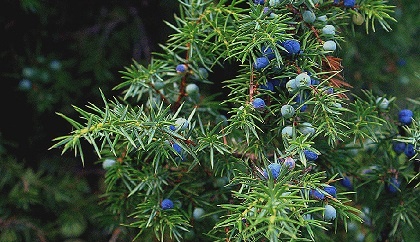
A new report from Plantlife shows that Scotland's gin-flavouring plant is in decline and being killed off by a deadly disease.
The plant is characterised by its greenish blue needles and the dark purple berries that give gin its aromatic flavour. Rooted in Scottish culture and an iconic feature of the landscape, juniper is now under threat from a new fungal disease.
Phytophthora austrocedrae, first recorded in Argentina in 2007, is having a severe impact on juniper bushes. New sightings of Phytophthora are being found regularly. Phytophthora is an air-borne fungal pathogen; it is still not clear how it is distributed, although it needs wet conditions to thrive. Once infected, bushes go orange, then brown. So far, this disease has only been recorded in Argentina and Britain and it is not known how the disease arrived in the UK.
A new Plantlife report published this weekend indicates that juniper is in a critical state in Scotland. It found that 63% of bushes surveyed were found to have brown patches - a sign of ill health or disease.The conservation charity is concerned by the results of a citizen science survey focussed on the health of juniper in the country. Juniper has already been lost from a quarter of areas where it was previously found.
It is important, not just for its cultural value, but also because it provides food for wildlife such as the juniper shield bug - a key native invertebrate, important cover for game bird and shelter for stock. There is a growing interest in locally sourced juniper for Scottish gin distillers, which is reinvigorating the use of Scottish juniper.
Deborah Long, Head of Plantlife Scotland said: ''Volunteer citizen science surveys are helping us understand what is happening to juniper in Scotland.
"We know juniper populations are struggling, but they now face an additional threat. It is thanks to these citizen scientists who have been helping us monitor the species, that we can start working with land owners to help juniper communities become more resistant to the threats they face, including this new disease.
"We need to ensure juniper has a future. It needs active conservation effort and intervention now for it to survive."
Murdo Fraser, MSP for Mid Scotland and Fife, said: "Juniper is one of our most iconic species. Used not only by birds as cover and food, juniper is a key native plant for human use too.
"Today though, juniper is in trouble. Plantlife's report is a call to action for us all to do what we can for juniper and to ensure that future generations get to smell crushed juniper berries and delight in the assorted shape and sizes of juniper in our countryside. Land manager, visitors, conservationists and politicians can all do something for juniper."
Many juniper bushes are over a century old and unable to regenerate because land management practices have meant that they have been unable to set seed successfully. According to the report, 79% of juniper recorded in 2014, was either mature, old or dead.
Juniper is either male or female, so it can be challenging for the plants to pollinate successfully, especially amongst isolated plants. These isolated communities become fragmented as land use changes, or where afforestation has occurred. Juniper seedlings are quite fussy - they need bare ground to establish, and are easily outcompeted by other plants due to their slow growth. In addition, the young plants are vulnerable to vole grazing.


 Man, 44, seriously injured in hospital after crash between Comrie and Rosyth
Man, 44, seriously injured in hospital after crash between Comrie and Rosyth
 John Swinney announces SNP leadership bid
John Swinney announces SNP leadership bid
 Closures on A92 from TONIGHT for roadworks
Closures on A92 from TONIGHT for roadworks
 16°C
16°C
 13°C
13°C